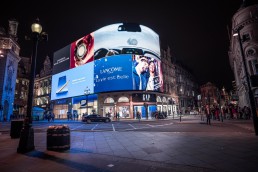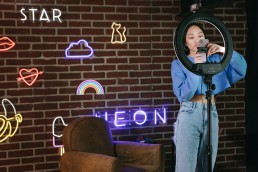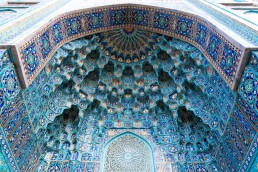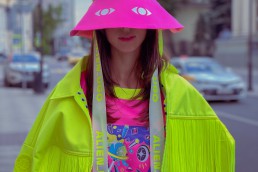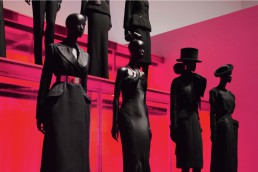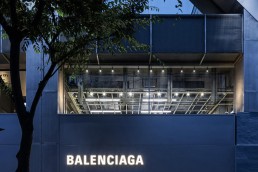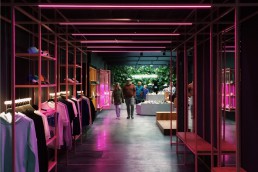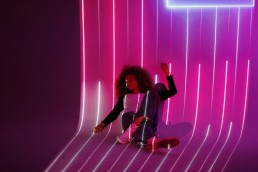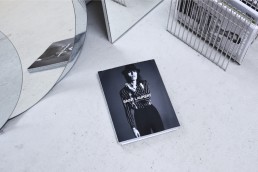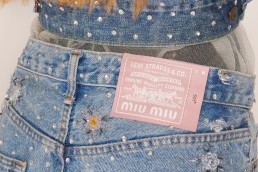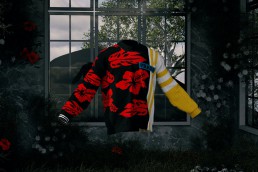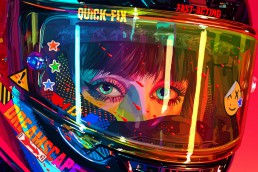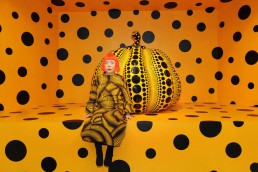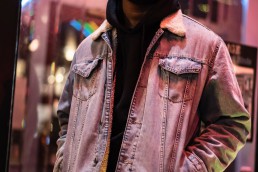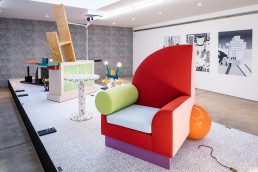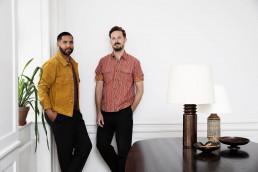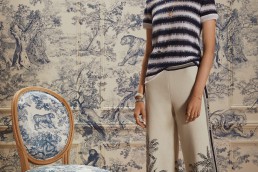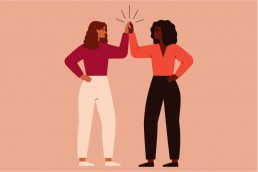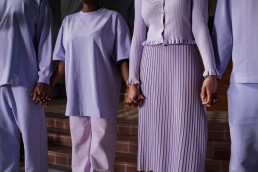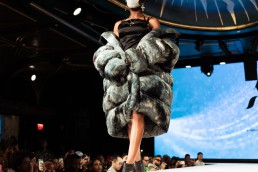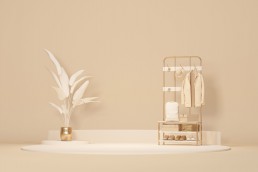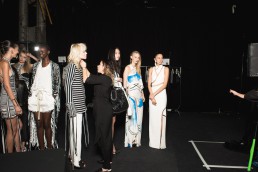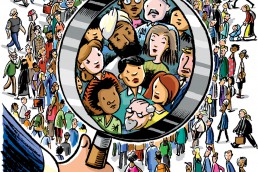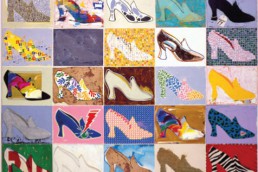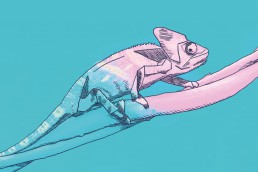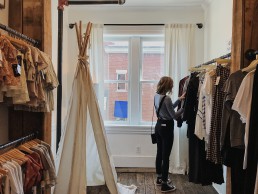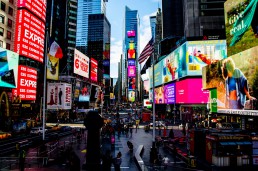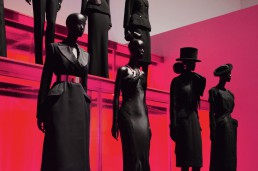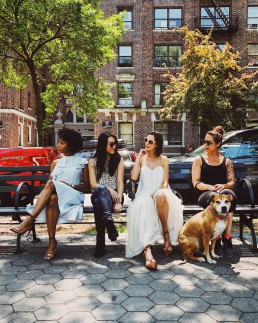How to Create a Fashion Portfolio
In an ever-changing work environment, all creative professionals need a portfolio to showcase their work projects to possible new clients or access a dream job. Today we share some tips in creating portfolios for the fashion and lifestyle industries.
A fashion portfolio will help you to be prepared when looking for a job in a fashion brand or agency. Fashion portfolios are really common among creative professionals such as fashion designers, stylists, photographers, journalists, and communication specialists.
The aim of creating a personal portfolio is to tell the world who you are as a designer or fashion professional. It should contain everything you already have accomplished and a projection of who you want to become in the future.
If you are a student or you recently started in a fashion or lifestyle career outlet, prepare yourself to be more competitive and create a fashion portfolio that truly represents your essence and motivations.
Fashion portfolios are a professional tool that can give you visibility with headhunters through social media or creative hubs; they could also serve as the perfect extension of a more traditional cover letter to send to a Head of Design or HR inside fashion brands.
The formats of a fashion portfolio have changed over the years, although the basic structure still remains, as their aim is to show your capabilities and skills. Digital/online formats are very popular, they can be accessed 24/7, with a worldwide reach. A physical format is well-appreciated, very suitable for timeless projects, and if you want (or need) to have a printed “book” to show your work in a personal interview.
How to Prepare Your Fashion Portfolio: Easy Steps and Tips
Select Your Best Projects and Curate the Images
If you are a young creative, sometimes this task can feel overwhelming, especially if you have not worked before on up-scale projects. This should not be an obstacle, all fashion creatives started the same way.
If you have some junior experience, the process is the same: collect, edit, and finally select your best projects. Try to categorize your work in tags, by theme or type of execution, this way you will give consistency and sequence to a project series.
Once you have an accurate overview of the best projects that represent your professional work, start curating the images that are going to be attached to the projects.
The fashion and lifestyle industries place a high value on aesthetics, so be sure to create a balanced selection of images that enhance and showcase your creative outlook.
Find Your Personal Brand Signature
Your portfolio needs to be structured under a carefully designed layout. Try to create an original graphic layout (although if you struggle with that, there are websites specialized in templates), that harmonize with your curated images. Add your name or logo to the layout if you have already developed it, then find a proper way to include it in with some graphic guidelines. This way, every part of the portfolio’s layout will have your personal signature and touch.
Show Your Range: From Concept to Sketch and the Technical Aspects
Your fashion portfolio is your introduction to possible new clients or to show your creative range in a job interview (digitally or in a one-to-one meeting), it must be self-explanatory, avoid elaborate structures that complicate the comprehension process.
If you worked on a fashion design project, explain the starting point of the collection, it can be a concept or an inspiration, including the mood board or some brief explanatory text to support the concept. This part of your portfolio highlights the unique ideas, personal interests, culture, and theoretical references you bring to your work.
Don’t forget to include the applied part, such as sketches, the collection line-up, the spec sheet, and if you have one, the 2D or 3D model drawings. Try to follow a three-step process to present fashion projects: concept/idea, technical aspects, final result. This approach shows project development in a precise, and professional way.
Showcase Your Abilities, Skills, and Professional Interests
All creative projects have a place in a fashion portfolio. A portfolio can include many creative outlets such as styling a photoshoot, a fashion article, a fashion editorial, a fashion communication ad, or an ad campaign. Every creative project is proof of your skills and capabilities. The goal is to depict your versatility as a professional or the opposite hand, your specialization in a field.
A digital fashion portfolio can help you to boost your online presence. Put the link to your portfolio on your social media, as you never know where the opportunity may come from. Create your portfolio with honesty and humility, and be ready to tell the world what your expertise is.
Fernando Aguileta de la Garza (ELLE Education Business)
Artisanal vs. Digital Approach: Why Both Dimensions Are Important in the Fashion-Luxury Business Ecosystem
In a world where every step of business is going digital, within the fashion industry, balancing a human approach, nurturing artisan skills, and integrating the benefits of digital seems like an opportunity to keep the distinction of “the business of dreams”.
If a machine can do everything for everybody, then where does its unique quality lie? Are the technical processes better than handmade? Does fashion depend on high craftsmanship to elevate prices? Is digital fashion displacing the sensorial attributes of garments?
Intricate questions to answer, as nothing is black or white, there is a vast gray area between combining technology, know-how, and getting the best of both worlds. Finding proper responses that articulate the business reality, the social side of the fashion industry, and responsible solutions for the future will be the only way to go forward.
Theoretically, luxury can be a departure from the norm, something unusual. Also, it can mean distinction: linked to physical attributes. The bourgeois concept of luxury is related to the role that the Industrial Revolution gave to the court of suppliers, back in the nineteenth century.
The aristocratic and artisanal models were rooted within the production models before modernity entered the scene. Luxury goods were carefully crafted by highly skilled artisans and relied on exceptional quality, raw materials, and producing small quantities, as scarcity is one of luxury’s rules and precepts.
High-Fashion and Couture business models rely on exclusivity, an extraordinary material sourcing selection, and bespoke tailoring. Their business purpose is against mass production as the higher the availability, the lower the prestige will be.
On the contrary, startup business solutions, hyper-fast fashion internet players, and specialist e-retailers have relied on technology, the digitization of processes, and the hyper-fragmentation of activities related to garment manufacturing to keep the costs under control and obtain profits. Digital does not always follow an ethical perspective either on the planet, or the fashion workers.
In the fashion, luxury, and lifestyle businesses, there is no magic recipe to success, as change and product alterations are the basis of novelty that the fashion system requires and needs to exist.
The artisanal and digital approach brings up the conversation about serving local versus global. Neither of these two aspects is mutually exclusive.
It Is Possible to Be a Global Luxury Brand and Have a Significant Impact on the Local Communities
Chanel is a classic example of that approach. On one hand, due to the lack of artisanal processes and techniques affects directly the brand’s value proposition, and on the other hand, they understood that -at least in the luxury segment- cannot exist one without the other.
Since 1985 the Parisian house has been acquiring small ateliers and artisanal businesses, in a clear strategic move to secure their supply chain and preserve specialized crafts, the base of French’s “savoir-faire”. The Paraffection subsidiary is the holding that includes embroiderers such as Lesage and Montex, over jewelry makers Goossens, shoemaker Massaro, feather specialist Lemarié, milliner Maison Micher, and knit specialist Paima.
The goal of Chanel is to preserve and promote the heritage, craft, and manufacturing skills of fashion artisan workshops. The workshops maintain independence from Chanel Inc. as they can supply orders from other rival fashion houses such as Balenciaga, and Valentino.
This artisanal club is held under one roof, the recently opened Le19M, a multidisciplinary complex designed by architect Rudy Ricciotti, where 600 artisans and specialists have gathered inside the métiers d’art ateliers, a gallery, and a school.
“Techniques are plentiful, they can be developed and passed on …they have to be attached to a tangible reality. Fashion is creation, but creation is embodied in tangible products that are underpinned by know-how, by people who have learned [these skills] and who transmit a kind of magic touch to these products… Without craftspeople, where will we be in 10 years? And that’s not just a question for Chanel”, stated Bruno Pavlovsky, president of the brand’s fashion division, in a Women’s Wear Daily article.
Another example of commitment is the Loewe Craft Prize. The Loewe Foundation seeks to “acknowledge and support international artisans of any age or gender who demonstrate an exceptional ability to create objects of superior aesthetic value. By identifying work that reinterprets existing knowledge to make it relevant today while reflecting its maker’s personal language and distinct hand”. In their journey, the luxury brand Loewe aims to highlight the continuing contribution of craft to nowadays culture and reward, “the most outstanding, representing excellence, newness, innovation, and artistic vision in modern craftsmanship”.
Digital, as well, can offer endless possibilities for presenting the product engagingly and beautifully. Craftsmanship finds no contradiction in the use of technology to uplift the final result of fashion products.
In a digital paradigm, it is easier and faster to communicate but is difficult to convey the sensorial experience. Digital can bring innovation to the work of artisans and craft houses: 3D prototypes, digital modifications, digital presentations, and the use of artificial intelligence in the cutting, sewing, and finishing processes of garments.
Craftsmanship is knowledge, digital connects the dots between that knowledge to make it more efficient and durable over time. If the fashion industry manages to combine both dimensions, its innovation -and permanence- will be assured.
Fernando Aguileta de la Garza (ELLE Education Business)
The New Visual Merchandising: Innovating Ideas in the Retail Landscape
Today we share the latest ideas emerging in Interior Design for commercial spaces. Visual merchandising for fashion is more alive than ever, as physical interactions are on the rise.
Visual Merchandising is linked to consumer emotion. Creating attractive visual elements in shopping environments is mandatory to capture the consumer’s attention. Visual Merchandising is a useful promotional tool in fashion retailing, as it helps to showcase information about the brand and products visually.
A detailed plan of Visual Merchandising enables keeping your brand differentiation at its best, sparkling brand awareness among your customers, and creating product atmospheres that balance the practical and emotional needs of your customer base.
Visual Merchandising can activate different behaviors in the customer, such as surprise, delight, product recognition, and hopefully purchasing.
According to authors Bailey and Baker on Visual Merchandising for Fashion, “the physical shopping experience is emphasized as being one of the most important platforms to visually market products”. One of the main objectives of Visual Merchandising is for the customer to spend as much time as possible in the store. A visual merchandiser can design the customer experience to attract, surprise, entertain and seduce the target customer.
Why Do We Implement a Visual Merchandising Strategy in a Store?
Here is a list of reasons why the visual presentation of a brand matters:
- To communicate visually the brand identity
- To increase brand recognition.
- To create the atmosphere of a new collection.
- To add impact and enjoyment to the in-store walls.
- To push a communication advertising campaign.
- To emotionally connect with the customer and simplify their shopping experience.
- To create immersive and highly engagement environments.
- To drive customer traffic to the store due to spectacular window-dressing.
- To increase sales by maximizing space and product display.
- To establish consistency between digital sales channels and the traditional store.
New Rules and Innovating Ideas in Visual Merchandising
1. From the Store to Social Media: Visuals Adapted for the Internet
Everybody knows that having a social media presence is imperative for any brand in the fashion and lifestyle businesses. Online visual merchandising relies on amazing photographs, attractive videos, and call-to-action messages to the customer.
For a curated visual merchandising experience in real life, the store is your operations base. Mix both worlds and blend them. When in mind a traffic strategy you can design a spectacular display that triggers your customer to immediately want to upload it to its social media.
Bold colors and textures, giant structures, and interactive “Instagrammable” photo-ready are the ones that work best.
2. Arty Displays: Elevated Visual Merchandising
When mixing visual merchandising and artistic references, you cannot go wrong. People love art expressions, paintings, structural-vibe displays, and over-the-top window dressings. As a brand, you should inspire them to come closer to your world. Music, theater, films, and contemporary aesthetics are some of the creative roads to explore.
Invite an artist to intervene in your store or window. Ask him to do something unique for your brand that is meant to catch your customer’s attention.
3. Upcycle Your Product Displays
Sustainability is not just a faded trend; it is a commitment. A new approach to visual merchandising is not only to recycle your prop materials but also to upcycled. Ask your creative team to reconsider what new uses and transformations of past visual merchandising materials in storage can be made. Reinvent your stands, racks, and display cases with second-hand products, transform them, think of unusual materials and make them work.
4. Colors as Trademark and a Back-to-Nature Approach
Some luxury fashion brands have been associated with a specific color to make it their hallmark. Shop walls, street windows, mannequins, and fitting rooms in a color block statement.
The return of massive plants and flower decoration in visual merchandising strategies is not a coincidence. Customers were craving nature, outdoor sensations, and a more natural mood environment.
5. Customers as Props and “Chillin’” Spaces
“See and be seen” in the “right” shops and fashionable streets is a trending idea. Turn your customer into your best sales claim. Allow your customer to enjoy your store, to sit down to have a coffee, or blend in with furniture to rest and socialize while shopping. The motto: “it is more than a store, it is a lifestyle”, has to be in the minds of the visual merchandising team. It is the big picture that matters in a store atmosphere.
The new rules of attractive visual merchandising are written continuously. You will need to stay current and unleash your imagination to keep your visual strategy forward-looking and competitive.
Fernando Aguileta de la Garza (ELLE Education Business)
Why Storytelling Can Help Your Brand to Grow
The art of storytelling is a classic way to connect emotionally with customers. Today we explain some facts about why storytelling matters for a brand’s communication strategy.
Nothing is more powerful than a good story. It captivates, inspires, and drives us into action. A well-told story connects to our deepest feelings and makes us identify ourselves with that particular story.
Brands are no strangers to making us fall in love with their stories and anecdotes, as their objective is to create a community around their purpose.
If you have a fashion brand and you need to create its storytelling, continue reading this article to learn some essential steps in creating a brand story.
Every good story starts with a key ingredient: honesty. To tell your story it is essential to know who you are -as a brand- and what do you represent. In other words, you must have a well-defined brand identity.
Brand identity is a system of values and precepts by which the brand moves, communicates, and promotes. If we lack a clear identity, our story will not be authentic, and authenticity is the key to connecting with our customers.
Storytelling is a branding tool that appeals to emotions, stories, myths, and legends engraved in our minds. Storytelling evokes our memories and presents the final brand story with a recognizable narrative to identify with.
Brands with a solid brand story are more likely to grow their community. First, because they focus on emotions and storytelling and not -only- on their product. Second, a sincere story wins over the communities and turns them into prescribers. Remember, a brand without customers is nothing.
Well-done storytelling techniques can help the brand to tell not only its origin but also its achievements, milestones, dates, and motivations.
An amusing story humanizes the brand and connects its values with the present, whether it is dealing with global issues or a social cause. Many of today’s consumers are looking for brands committed to fair business practices while improving the lives of their customers.
Storytelling can make your brand memorable. Data is often forgotten, stories are not. Include your storytelling throughout your brand voice, you will be consistent and repeat the story in the brand’s different communication channels.
How to Get Started
The brand story is a fundamental narrative axis that must be present in all your communication. According to Stern in Authenticity and the Textual Persona: Postmodern Paradoxes in Advertising Narrative, there are three starting point elements of a story: chronology, causality, and character development.
Chronology establishes the story’s tempo, as a beginning, middle, climax, and ending. Causality underlines the relationship between actions, for example, decisions made by a character to achieve a goal or solve an issue leading to an outcome. The character development shows the mind of the protagonist; what he or she desires and what motivates him or her internally.
1. Outline the Protagonist’s Journey and Character
The brand story must feature a protagonist or narrate a momentous event. We can strengthen our story by drawing on the universal archetypes present in all stories whether it be a hero, a joker, a savior, a genius, or a sage, to name a few. Archetypes are flexible and guide us to build an authentic story worthy of our brand. Storytelling provides its main character with a unique personality.
On the contrary, the absence of a protagonist in favor of a collective does not get in the way of creating a powerful and credible brand story.
In this case, it is worth highlighting the group’s milestones and challenges, as well as its path to achieving them.
2. Make Sure You Have the Key Elements for a Great Brand Story
As mentioned at the beginning of this article, authenticity is mandatory when writing or speaking your brand story. You need to convey to your customer to believe in your story and associate it with their reality.
You need to be concise when creating your story; present it in a clear and untangled way, while still covering all the important points to be understood as a whole.
Create a reversal, a climax, or a turning point. Unleash actions into a surprising twist or increase the level of emotion. This narrative will point to the journey or the motivations at its best.
Introduce a little bit of humor, your story does not have to be a comedy itself, but we all feel related to a sense of humor. You can introduce jokes and use some puns to command a positive reaction from your customers.
Storytelling has been proven to add positive brand associations, and in the long- term, strengthen brand equity.
If you create your brand story from authentic attributes embracing core brand values, certainly you will make a difference compared to other competitors who use traditional and static forms of marketing and communication.
In addition, storytelling fosters emotional brand connections and has positive effects on brand attitudes and purchase intentions among customers. Without a doubt, this is how storytelling can help your brand grow.
Fernando Aguileta de la Garza (ELLE Education Business)
How to Write a Brand Manifesto
A clear brand identity and values are necessary to create a brand manifesto, a declaration of intent where emotion is everything. Today we share some ideas on how to create one.
The brand identity in the corporate branding context is shown through the brand’s physical dimensions such as products, name, graphic design, and expressed through the brand image and personality.
A brand aims to develop a core identity that is consistent over time, avoiding fades at all costs. A brand manifesto is an articulate statement of intent, a clear synthesis of what the brand stands for, for customers and the world.
The brand manifesto is a creative statement; it is inspiring, and talks about the brand’s relationship with the user. It connects with rational motivations, and -most importantly- with the gut and the emotions that tie the customer to the brand.
An honest brand manifesto motivates and portrays the reason why brand employees and managers believe in the purpose of the brand every day at work. The brand manifesto transcends any corporate mission, vision, and values -although it draws from them-. The brand manifesto is driven by authenticity, it has to express it through points of view, values, and attitudes.
A brand manifesto cannot be based on trends or commercial claims; it is not a corporate slogan. For a brand, this is a declaration of principles implying internal-external values, a defined brand personality, and a reason to exist beyond commercial exchanges and brand profit.
Ethics and brand intangibles are required to create an honest manifesto. The process will force you to reflect on the essential emotional root of your brand and how, through it, it transforms your client’s life.
Brand manifestos are not written under extreme formalities, they are a creative exercise that conveys facts, dreams, aspirations, and motivations. Remember, when creating a brand manifesto, you are not selling your products or services, you must think beyond that.
A purpose encloses values, beliefs and distances us from our competitors. Therefore, selling (and representing) something more than a product or service is essential to position the brand at an emotional level.
How to Write a Brand Manifesto: Tips to Do It Creatively
First of all, you need to define your emotions, going beyond rational attributes and product benefits. You can conduct a focus group among different teams inside the organization to extract precise brand information. Sharing the brand’s story, milestones, and anecdotes can lead to open dialogue defining the brand story as a creative process.
You need to set clear the company’s intentions and motivations because when writing a brand manifesto, you want to evoke an emotional response in the audience. The emotional statement aims to drag your consumer’s attention and give them something they can relate to.
A brainstorming session can help you write down clear answers for some brand aspects that can lead you to connect with the brand’s truth.
You can discuss relevant questions with your team to generate new ideas, such as:
-How is the brand contributing to creating a better world?
-What social values do we stand for?
-How do we make our customer’s life easier, happier, or more productive?
-What is the brand essence or core DNA?
-Is there a background story related to founders?
-Why does the brand exist?
The answers will focus your complete attention on the brand’s core purpose and give you clues to write a declaration guided through ethical drivers beyond competence. The key is being authentic and giving the consumer a reason to care.
When creating a brand manifesto, you must realize you are appealing directly to your customer. Be approachable, use pronouns like “we,” “you,” “us”, you are telling a story, be honest in order to engage with them. The creative writing of a brand manifesto brings your client closer to your brand’s narrative.
The brand manifesto must be concise but inspirational, clear enough but leaving space for imagination, universal yet personal to connect. The brand manifesto is not a “look how cool we are” slogan with no real meaning. As discussed before, the manifesto is a creative form of pure honesty.
A brand manifesto must invite customers to act or feel identified in the shared dreams, goals, and ethics. Use the brand manifesto in your communication strategy and spread your purpose. The manifesto will guide and convey what you represent as a brand, and how you are changing your customer’s life.
Think of a brand manifesto as a bridge to create new and lasting human connections. It is your brand journey, celebrate it, honor it and fulfill it. If the brand manifesto is written from the heart, customers will notice.
Fernando Aguileta de la Garza(ELLE Education Business)
Digital vs. Outdoor Advertising: How Fashion Is Taking Over the Streets
This season’s fashion advertising strategies have surely surprised many fashion advertisers and public relations professionals. It seems that when it comes to advertising, the best way to get ahead is to go back to basics.
Long live the street, the ultimate battlefield for any fashion brand to consolidate any trend diffusion. After the pandemic lockdowns, combined with restrictions on the street, it seems that all fashion advertisers have become obsessed with outdoor strategies.
Over the last decade, digital advertising has increased its power against traditional advertising. According to ReportLinker in the Global Digital Advertising and Marketing Industry, the worldwide market for digital advertising spending in 2020 was estimated at US$350 billion. Their expectation for the next six years is to reach a revised size of US$786.2 billion.
The U.S. market was estimated at US$155.3 billion in 2021, while China is forecasted to reach US$254.9 billion by 2026. As a consequence of the COVID-19 pandemic, “the large increases in online traffic provided opportunities for companies to keep their target audience engaged through digital marketing initiatives. While overall digital marketing spending declined due to the pandemic-induced cuts in marketing and advertising budgets during the lockdown, available budgets were directed at digital marketing initiatives”, according to the same report.
Despite those numbers being exceptionally tempting for brands to invest in digital marketing, the fashion industry players are relocating their ad budgets to tangible PR events, and physical and on-the-street displays as well. This atypical movement against the trend does not mean their digital strategy is to cut the budget, on the contrary, the more channels a brand integrates into its communication and promotion strategy, the better.
Outdoor Advertising: “Hello Fashion, I’m Back”
According to market research and consumer insights Premise, “many companies and businesses clamor for high foot traffic areas, spaces, and spots for outdoor advertising. It is because outdoor or out-of-home (OOH) advertising helps get and build brand recognition”.
OOH advertising is used to promote services or products in specific geographic locations, billboards and street furniture are emblematic examples. According to Premise, “it communicates the message to the target audience and gives them maximum exposure”.
Besides gaining brand recognition at niche locations, outdoor advertising is all about attracting attention and triggering an immediate response whether it be emotional or rational. Outdoor ads can inform the customer about the latest brand activity or launch.
Among outdoor advertising, we can find different formats such as billboards, lamp posts, transit ads, cinema ads, and guerrilla advertising.
In this unusual twist, wouldn’t it make sense that in a hyper-connected and digitally monitored world, people would want more than just be staring at a smartphone screen?
Street traffic, brand happenings, street flash-mobs, or a monumental display is what fashion consumers are craving. Digital marketing has not killed the classic advertising star after all.
One of the first signs of shifting was the official return of the fashion calendar and staged runways. Now the movement is on as the presentations of the cruise collections are just around the corner. The creative director of Christian Dior, Maria Grazia Chiuri, will show her latest collection in the Andalusian capital, Seville, in a privileged location this month: Plaza de España. Similarly, Chanel returned to stage their cruise presentations in an international yet-familiar place to the brand’s ethos: the principality of Monaco.
Bottega Veneta placed the brand’s Wardrobe 02 collection advertising on a rooftop on Los Angeles International Airport (LAX) flightpath. Passengers on the flight were able to view advertisements for dancer Roberto Bolle and musician Arca from the sky upon arrival and departure from LAX.
Farfetch displayed its latest advertising campaign starring the British-born actress Kim Cattrall in -the legendary- Sunset Boulevard, with an exceptional press and audience reaction for the new spring 2022 campaign titled #YourChoiceYourFarfetch, the Internet went crazy.
Kerby Jean-Raymond of Pyer Moss did a similar move to promote the brand’s first bag collection on a billboard on Flatbush Avenue. Certainly, a location on-brand, as Flatbush is one of Brooklyn’s most diverse neighborhoods with the presence of Jamaican, Caribbean, Pakistani, African American, and Latino communities. Jean-Raymond himself is an advocate for diversity and inclusion within the fashion system.
For brands such as Loewe and AMI Alexandre Mattiussi, the French capital is their playground. Loewe unveiled the SS2022 campaign on a billboard in La Madeleine in Paris. As for Mattiussi, he staged his FW2022 collection in a parade inspired by the Paris metro and its eclecticism defined as “a travel in space and time…a place where everyone mixes and blends, where trends develop”. It was an invitation to passengers to discover an elevated reality. Lately, AMI has run a brand recognition campaign with billboards in New York, Los Angeles, Seoul, Hangzhou, Beijing, Chongqing, and Paris.
Even digital strategies emulate outdoor activities. Coperni’s latest collection is a look-book resembling a smartphone home screen with the Paris weather changeable forecast. Founders Sébastien Meyer and Arnaud Valliant wanted to bring the collection out of the runway and into the streets.
Outdoor advertising is the fashion’s latest attempt to reconnect with consumers organically and maybe, to move the brand experience out of -only- digital strategies. After all, the street is where fashion battles take form, don’t they?
Fernando Aguileta de la Garza(ELLE Education Business)
What Product Development Strategy to Follow for a New Fashion Collection
Fashion design entrepreneurs need to develop a product strategy to satisfy market desires and, at the same time, reinforce business profitability. Today we share some ideas on how to create a fashion product development strategy.
In fashion, garments have always been at the heart of the business. In today’s global landscape, fashion products are in the spotlight of the consumer, who demands to know the details of sourcing and manufacturing processes. New fashion brands or lifestyle projects must offer efficient, accurate, and planned management of fashion products to avoid waste and lack of transparency in the supply chain.
The fashion business is the business of trends and aesthetic tastes, therefore, a fashion collection must respond to a brand concept, including style, shapes, and the quality of the garments.
The collection must respond to a strategy aligned with the brand’s values and its singular aesthetic. Strategic product development is a set of material, symbolic, and service attributes that are expected to provide tangible benefits and measurable satisfaction to the consumer.
A proper fashion product responds to emotional, psychological and, of course, social factors. Fashion design in commercial terms is based on giving the customer what they want, even before they realize they want it.
Fashion products possess attributes that differentiate them from any other consumer product. For example, fashion collections are created from the point of view of design, quality, and utility. In addition, the collection must have a degree of novelty, and a price in line with the symbolic attributes of the brand.
The product mix for any fashion company is extremely important. Inside the product development, intrinsic aspects of the product are involved such as fabric, sizing, applications, finishes, patterns, design, or fittings.
When developing our product selection, we must take into account the classification that our brand has or wants to achieve. Also, the range of products that should appear in the collection, for brand and target coherence.
Product planning will be different if we specialize in leather, for example than if we specialize in knitwear. The seasonality of the product is also another factor to take into account, it is not the same to produce a swimwear collection as it is to produce a winter sports collection.
The brand’s product range is another factor to consider. If we create tailor-made products, we will have a different product planning and strategy than creating ready-to-wear collections.
The use occasion of the products is a key aspect when you define the aesthetic of a collection, besides the combinability of the garments and their depth range of pieces for production volume.
Product Strategies for New Brands
There are no magic recipes when we are fine-tuning a fashion collection. The strategy is multifactorial, firstly due to the standard variability of the fashion business and secondly, due to the specific wishes and aspirations of the customer we are targeting.
Below, we explain some product strategies that you can apply to your brand and the steps to follow to focus on your product strategy.
Perform Product Reviews Integrating Multidisciplinary Teams
A product review is necessary to understand what we are designing and manufacturing from a 360-degree perspective.
It is worth setting up meetings before, during, and after the creation of a fashion collection, bringing together the design team, the sales team, the communication team, and the marketing team, as well as the managers. Remember that a collection plan is an ongoing, modifiable, and adjustable process. All opinions are welcomed.
Internal teams can bring a different vision that enriches the fashion collection. Either increasing the commercial vision of the collection or ensuring that the product created is on-brand for promotion in fashion shows or communication campaigns.
Structure the Product Line of Your Collection According to the Market
Strike a balance between product creativity, novelty, and realistic sales expectations. The worst thing you can experience when launching a new brand is reaching the end of the season with an excess of stock. To avoid this, your production must be flexible, and partner with manufacturers that help you create small and fast product runs.
You must take into account the extension of the brand’s lines. For example, many new brands want to sell menswear and womenswear simultaneously. Perhaps it is desirable to start in just one category and see how the professional buyers and the final consumer respond to it. Focus your efforts on a single product line and expect growth -organically- step by step.
Inject Novelty Into Your Collection, but Build a Recognizable Product
The best product strategy is the one that takes into account four product objectives to create inside a collection: the fashion products, the basic products, the classic products, and the products developed for the press. This mix of categories can help you define the variety of your product range, as well as introduce updates to your classic products. You must focus on seasonable fashion and press coverage without leaving the commercial aspect behind. The ultimate challenge for a new brand is to create the best-selling product; the one that works commercially and, at the same time, can become your signature product.
Fashion product development strategies for new brands must be flexible, dynamic, and creative. Testing the product is the only viable and accurate way to refine the collection and improve it over time.
Fernando Aguileta de la Garza
Why Can Brand Archetypes Help You Focus On Your Brand Purpose?
Today we share some simple steps to create a fashion communication strategy for your brand or service, from goals and planning to a specific course of action to follow.
The brand archetypes methodology is used within a branding perspective and can help you structure your brand story, define its values, and develop a unique personality.
Many internationally recognized brands use the archetypes technique to connect with their audiences on a deeper level. The framework helps them to apply knowledge from psychology, human behavior, myths, and legends.
Brand identity governs all aspects of the brand, it is guided by the journey of the archetype to then integrate it into all the key axes of the brand.
Branding expert Jean-Noël Kapferer developed a brand identity structure integrating six facets of the brand such as physique (product features, symbols, and attributes), personality (brand’s character and attitude), relationship (beliefs and association), culture (set of values), reflection (customer’s view of the brand), and self-projection (customer’s internal mirror as a user).
Kapferer’s framework is compatible with the theory of archetypes as it provides a starting point for building your brand story, and how you will communicate with your customers. Archetypes provide a set of values, a specific personality, and a journey to fulfill.
This useful tool in brand building provides a common base structure for either the brand or the customer to identify and begin a relationship with shared aspirations and, later, reflected into the brand’s communication.
The term “archetype” was coined by psychologist Carl Jung, in the context of personality. He argued that humankind shared “ideas that people at first find strange but soon come to possess and use as familiar conceptions”.
Archetypes are the common heritage of mankind. Carl Jung identified two psychic levels in the human personality: conscious and unconscious. The last one was divided into the personal unconscious and the collective unconscious.
The field of the collective unconscious is where archetypes live, as it is the inherited part of the human psyche not developed from personal experience. This psychic expression of the collective unconscious is expressed through universal thought-forms or mental images that can influence an individual’s feelings or intuitions, resulting in typical patterns of behavior.
The archetype paradigm helps to guide brand developments as they often carry a strong emotional charge. From the psychology perspective, archetypes have been expressed as myths and fairytales, they relate to storytelling through motifs in history passing by dreams, visions, legends, and a collective representation of reality.
Brand Archetypes: Understanding the Power of a Great Story
Every brand must have a purpose, meaning a reason for existing and how as a brand, you are changing the lives of your client. Having a purpose is a very wise way of telling your audience who you are, what you stand for, and what you will never be.
Using purpose as the center of the business strategy will align all departments in one unique force, working together, being complementary to fulfill the organization’s mission and vision.
However, branding purpose is beyond corporate mission, as it encompasses attitudes, personality, values, methods, and manners of getting things done inside your brand.
In brand building each brand archetype has a particular mission in life, a certain set of values, a way for expressing their personality, and an audience to win over. You cannot be everything for everybody, you will have to choose what archetype suits your brand better.
There are twelve brand archetypes in brand building, their story recounts the brand promise, which declines in the physical manifestations of the archetype over the brand to be recognized by the customer. Archetypal branding is a tool that provides focus and consistency to the brand.
Below we mention the brand archetypes, their principal values, and vital purpose.
The Explorer
Values: Audacity, Independence.
Purpose: Discover the world without limits.
The Innocent
Values: Trust, Simplicity.
Purpose: Being happy in paradise.
The Ruler
Values: Control, Order
Purpose: Succeed by creating prosperity.
The Caregiver
Values: Generosity, Empathy.
Purpose: To help others.
The Jester
Values: Playfulness, Fun.
Purpose: To have fun in life.
The Creator
Values: Creativity, Imagination.
Purpose: Being original.
The Hero
Values: Courage, discipline.
Purpose: Overcome tough situations
The Lover
Values: Gratitude, Seduction.
Purpose: Become passionate.
The Outlaw
Values: Nonconformism, provocation.
Purpose: Being different & breaking the rules.
The Sage
Values: Experience, Intelligence.
Purpose: To seek the truth.
The Citizen
Values: Honesty, Respect.
Purpose: Connect with others.
The Magician
Values: Perspective, Wisdom.
Purpose: Transform reality.
There are four main groups to understand the brand archetype wheel. First, archetypes provide structure: creator, ruler, and caregiver. They lead by creating innovation, seeking control, and giving service; second, archetypes seeking paradise: innocent, sage, explorer. They seek safety, hunger for knowledge, and search for freedom; third, archetypes leave a mark in the world: outlaw, magician, hero. They seek liberation, yearn for transformation and win mastery; fourth, archetypes building connections: citizen, jester, lover. They seek belonging, wish enjoyment, and want intimacy.
Aligning your brand purpose with an archetype journey will make your story instantly recognizable and will give your brand a framework to build a meaningful personality, the right tone for communication, and strong storytelling.
Dive into the archetypes’ stories and use their flexible approach to strengthen your brand.
Fernando Aguileta de la Garza(ELLE Education Business)
How to Develop a Fashion Communication Strategy for Products or Services
Today we share some simple steps to create a fashion communication strategy for your brand or service, from goals and planning to a specific course of action to follow.
A fashion communication strategy is a tangible way of showing and communicating your brand’s essence and purpose. Also, it is a tool for promoting your products and services season after season from an innovative and creative perspective.
Communication is a natural way of connecting people, a vast field for exchanging ideas. On the other hand, fashion business communication is a corporate tool to engage with the brand’s audience, inform them about the brand and keep them updated about the latest launches.
Communication inside the fashion industry always involves contact. From a commercial perspective, it links supply and demand; if a trend is not promoted, it simply does not exist.
A fashion product communicates by itself; as the fashion product communicates a range of creativity, color, or form. In addition, it can reveal a source for design and a well-defined stylistic code.
The fashion brand communicates to persuade the prescriber, the intermediary, or the client. It does so through strategies and tools that are useful in the short, medium, and long term.
The base for your fashion communication is branded messages. That includes producing messages about the product, the price, the collection structure, the styling, the runway shows, and point of purchase ads, to name a few. This effort is a joint strategy between brand areas, from marketing and comms to design and visual merchandising.
How Do I Start a Fashion Communication Strategy for my Brand?
The first aspect you need to be aware of for developing a successful communication strategy is to set the goals to achieve and plan the following steps before any tactical action.
- Set Communication Goals
The winning goal of any brand communication strategy is to stimulate demand and desirability for the brand. You may want to build or reinforce a brand image in a certain market; you may want to launch or support a seasonal collection; you may want to position a brand against competitors or push sales through retail channels.
- Identify the Communication Target
In the fashion industry, the client is not the only target subject to communication efforts. Think which target you may want to persuade, for example, the distribution channels, the fashion media and press, opinion leaders, internal departments, or the final consumer. All targets count, as communication strategies work in synergies.
- Design the Message to Convey
A successful message must surprise and thrill the target. Also, raise the desire and interest in the brand to the point of making the consumer share our messages. Our content (messages) must balance rational and emotional attributes, offering facts and also the advantages our product has over competitors. Choose the format according to your goals: the message could be text, audio, visual, or a mix.
- Select the Communication Channels According to Goals
Develop the most coherent communication activity to convey the message. You can select among the well-established fashion tools at your disposal, such as advertising, graphic design, runway and fairs, a sales promotion, or public relations events. Use a combination of different channels, physical and digital, and ensure the consistency of the formats with each other.
- Create a Budget to Analyze Feasibility
Ask for prices and divide your communication activities from most to least important for the communication campaign season. This perspective will help you to decide which communication activities require the greatest budget investment and which of them are dispensable.
- Apply an Integral Communication Approach
Everything can be communicated, in today’s reality the customer has 24/7 access to the brand. Everything counts; from the retail windows to a brand identity manifesto; a paid media advertising in a fashion magazine; an Instagram campaign; a personalized message and promotion sent to the customer’s home; editing a company magazine; a customer relationship management (CRM) activity such as a newsletter or a targeted promotion; a fashion film or a celebrity endorsement. Think of a holistic approach to brand communication activities, listen to what your client has to say; the more you do it, the better, the monologue of a brand in fashion communication is outdated.
- Manage and Coordinate the Communication Processes
Create a timeline, a task control shared file and let’s do it. The communication mix only works integrated and sharply coordinated. Every communication action is oriented and limited by the communication goals, the brand’s market segment, and the operation control policies.
- Measure the Communication Strategy Outcomes
Collect all relevant information about the communication impact of your strategy. Define your key performance indicators (KPIs) to monitor your progress toward achieving your strategic goals.
There is no single recipe for successfully managing the communication of a fashion brand. The path asks us for perseverance, focus on brand purpose, and a lot of creativity. Dare to differentiate your brand with innovative communication strategies.
Fernando Aguileta de la Garza (ELLE Education Business)
What Is a Digital Marketing Funnel? And Why Is It Essential in Your Business Strategy?
Today we share some easy steps to understand what a digital marketing funnel is, and how to use the AIDA model in the best way for your marketing strategy to succeed.
Digital marketing is simple marketing, although from a technological and hyperconnected perspective, using the internet as the prime digital medium to interact with possible customers.
Digital platforms are increasingly rolling tactical marketing plans to capture your attention during your internet journey, either to search for information, ask a question, chat with people through applications or compare opinions about a product or service that interests us.
Look at these numbers and facts and consider them:
- According to GWI market research, a typical internet user between the ages of 16 and 64 spends close to 7 hours online.
- Digital 2021 Global Overview Report stated that more than 330 million people started using the internet in the past twelve months.
- The global internet users are up to 4.72 billion, meaning six in ten people around the world now use the internet.
- According to Statista, there are 4.28 billion mobile internet users, and over half of all Google search visits (56%) take place on a mobile device.
- 66% of companies use online advertising, and their favorite channels are: social media ads, display ads, paid search marketing, and retargeting ads, according to The Manifest.
If you have a brand or a lifestyle project, you should be aware of the benefits of a well-planned online marketing strategy.
You must be aware of the uses of a marketing funnel to capture attention and turn internet users or visitors into clients.
What Is a Digital Marketing Funnel Exactly?
A digital marketing funnel is a sequential strategic process that shows your customer journey from the moment they “meet” you online, to the moment of purchase of your products or services. The funnel takes into consideration the steps or the stage your customer is at, to identify what type of stimulus the client needs and drive to them useful content to help their purchase decision.
The digital marketing funnel is a framework to identify qualified internet traffic and convert them into customers. Some models play a relevant role in client conversion.
The AIDA Model:
This is a well-established model to cover the standard phases of the purchase decision process, and it is very simple to approach. AIDA is an acronym for Attention, Interest, Desire, and Action; these stages trace your customer’s journey attitude towards your product or service.
The digital marketing tactical goals must attract the customer’s attention; maintain customer interest over time; arouse desire, and finally, get into action.
Attention:
Consider the best ways to attract the customer’s attention, first to generate online traffic, and second, to create brand awareness. You should research what topics resonate with your targeted audience, such as needs, goals, interests, desires, and problems. Once you identify them, be creative in developing triggering content, being emotional or rational, to attract them to your brand.
Interest:
Be informative, do not be shy about giving all the support you can. If you already capture your customer’s attention, it is a waste of effort if you do not keep them informed and well-documented on your product, highlighting the product’s benefits.
Desire:
In this stage, people are comparing competitors, you must try to be on top of mind when they choose. You must project your brand as desirable, show them how your solution or products can fulfill their needs, and portray your brand in the best possible way.
Action:
Desire is nothing complete without a call-to-action. Make sure your customers take real action regarding your offer, such as clicks, subscriptions, inquiries, and hopefully, purchases.
A digital marketing funnel is useful to “convert” users or visitors into customers in the digital sales channels. A digital marketing communication perspective encourages the targeted audience to engage in a specific action.
Your task as a digital marketer is to generate visits and traffic to your e-commerce or your digital sales platform, then, to ensure visitors are captivated and also interested in what they find. Provide the information, comparatives, and ways to evaluate your products, make them decide. When they make an order, guide them through the process to complete the payment. At last, bind your client to the website or social platforms to encourage repeat purchases.
Digital marketing helps you to promote and sell products and services using marketing tactics such as digital content, social media marketing, online search marketing, and email marketing. Improve your digital marketing funnel, invest in understanding your customer, and continue developing creativity to keep it.
Fernando Aguileta de la Garza (ELLE Education Business)











